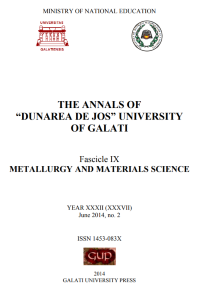Antimicrobial Properties of Semiconductive Oxide Nanoparticles. From Fundamental to Application
Abstract
A problem of modern society is the spread of diseases worldwide. Infection control and maintaining a high level of hygiene by applying antimicrobial coatings (including medical products, packaging materials, membrane filter/water treatment or filters in air conditioning) are of the greatest importance. Hospitals, pharmaceutical production, food factories must be thoroughly disinfected in order to destroy pathogenic microbes. Microbial contamination of water is a major threat to public health. With the emergence of organisms resistant to many antimicrobial agents there is an increased demand for improved disinfection methods.
Recently, the confluence of nanotechnology and biology has led to metals and metal oxides under the form of nanoparticles as potential antimicrobial agents. Nanoparticles have unique and well defined physical and chemical properties which can be manipulated suitably for desired applications. The applications of nanoparticles as antimicrobials is gaining relevance in prophylaxis and therapeutics, in medical devices, food industry and textile fabrics.
This work focuses on the properties of ZnO nanoparticles doped with different concentrations of silver. The mechanism of action of nanoparticles as bactericidal will be highlighted in this study. Specific applications of the investigated nanoparticles are presented.
Downloads
References
[2]. T. C. Horan, D. H. Culver, R. P. Gaynes, W. R. Jarvis, J. R. Edwards, C. R. Reid - Nosocomial Infections in Surgical Patients in the United States, January 1986-June 1992, National Nosocomial Infections Surveillance (NNIS) System. In Infection Control and Hospital Epidemiology, The Official Journal of the Society of Hospital Epidemiologists of America, 14, 1993, p. 73-80.
[3]. B. S. Atiyeh, M. Costagliola, S. N. Hayek, S. A. Dibo - Effect of silver on burn wound infection control and healing: review of the literature. Burns. 33, 2007, p. 139-148.
[4]. K. Tinker, Moment of Truth: Proper Air Flow Critical to Healthcare Laundries, In White Paper from the Healthcare Laundry Accreditation Council, 2010.
[5]. X. H. Wang, Y. M. Du, H. Liu - Preparation, characterization and antimicrobial activity of chitosan-Zn complex, Carbohydr. Polym. 56, 2004, p. 21-26.
[6]. Y. Inoue, Y. Kanzaki, The mechanism of antibacterial activity of silver-loaded zeolite, J. Inorg. Biochem., 67, 1997, p. 377.
[7]. A. Bacchi, M. Carcelli, P. Pelagatti, C. Pelizzi, G. Pelizzi, F. Zani - Antimicrobial and mutagenic activity of some carbono- and thiocarbonohydrazone ligands and their copper(II), iron(II) and zinc(II) complexes, J. Inorg. Biochem., 75, 1999, p. 123-133.
[8]. Z. H. Yang, C. S. Xie, X. P. Xia, S. Z. Cai - Zn2+ release behavior and surface characteristics of Zn/LDPE nanocomposites and ZnO/LDPE nanocomposites in simulated uterine solution, J. Mater. Sci. Mater. Med., 19, 2008, p. 3319-3326.
[9]. E. P. Azevedo, T. D. P. Saldanha, M. V. M. Navarro, A. C. Medeiros, M. F. Ginani, F. N. Raffin - Mechanical properties and release studies of chitosan films impregnated with silver sulfadiazine, J. Appl. Polym. Sci., 102, 2006, p. 3462-3470.
[10]. Y. M. Qin, C. J. Zhu, J. Chen, Y. Z. Chen, C. Zhang - The absorption and release of silver and zinc ions by chitosan fibers, J. Appl. Polym. Sci., 101, 2006, p. 766-771.
[11]. H. Zhongbing, Zh. Xu, Y. Danhong, Y. Guangfu, L. Xiaoming, K. Yunqing, Y. Yadong, D. Huang, H. Baoqing - Toxicological effect of ZnO nanoparticles based on bacteria. Langmuir, 24(8), 2008, p. 4140-4144.
[12]. S. Makhluf, R. Dror, Y. Nitzan, Y. Abramovich, R. Jelinek, A. Gedanken - Microwave-assisted synthesis of nanocrystalline MgO and its uses a bacteriocide, Adv Funct Mater, 15, 2005, p. 1708-1715.
[13]. J. Sawai, E. Kawada, F. Kanou, H. Igarashi, A. Hashimoto, T. Kokugan, M. Shimizu - Detection of active oxygen generated from ceramic powders having antibacterial activity. J Chem Eng Jpn, 29, 1996b, p. 627-633.
[14]. O. Yamamoto, M. Komatsu, J. Sawai, Z. Nakagawa - Effect of lattice constant of zinc oxide on antibacterial characteristics. J Mater Sci: Mater Med, 15, 2004, p. 847-851.
[15]. P. K. Stoimenov, R. L. Klinger, G. L. Marchin, K. J. Klabunde - Metal oxide nanoparticles as bactericidal agents, Langmuir, 18, 2002, p. 6679-6686.
[16]. Y. Kikuchi, K. Sunada, T. Iyoda, K. Hashimoto, A. Fujishima - Photocatalytic bactericidal effect of TiO2 thin films: dynamic view of the active oxygen species responsible for the effect, J. Photochem. Photobiol. A, 106, 1997, p. 51-56.
[17]. B. Halliwell, J. M. C. Gutteridge - Oxygen toxicity, oxygen radicals, transition metals and disease, Biochem. J., 219, 1984, p. 1-14.
[18]. M. Ibanescu (Busila), V. Musat, T. Textor, V. Badilita, B. Mahltig - Photocatalytic and antimicrobial Ag/ZnO nanocomposites for functionalization of textile fabrics, J. Alloy. Compd., 610, 2014, p. 244-249.



